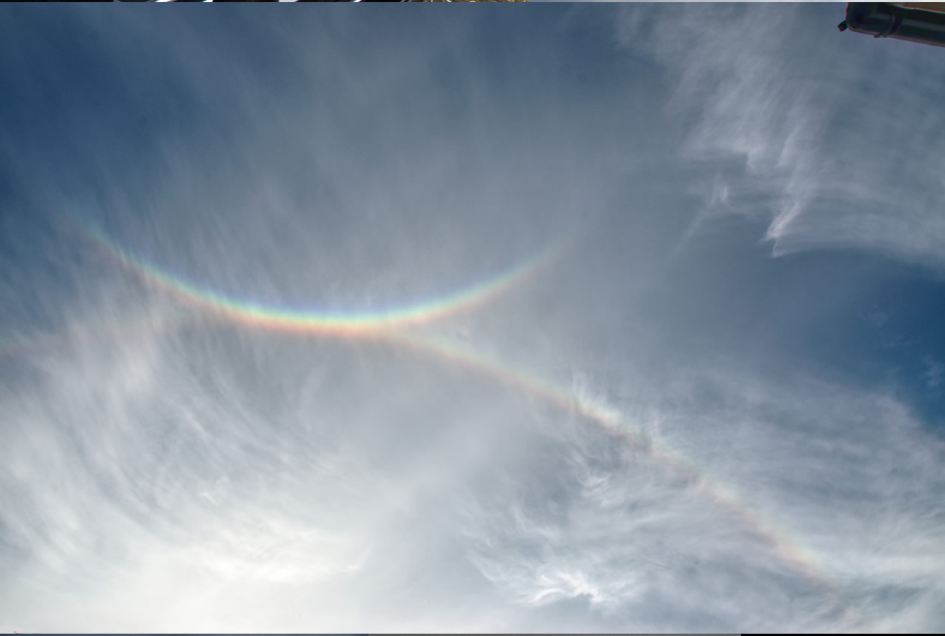Halos & How to Spot Them - OPOD
Halos & How to Spot Them - Exploring the Enigmatic Atmospheric Phenomena
Have you ever noticed a captivating rainbow-like effect on the surface of your car or a dark, curved reflection in a window? What you may have stumbled upon is an atmospheric optical phenomenon known as a halo. These ethereal displays of light can be elusive and awe-inspiring, but with a little observation and knowledge, you too can become a halo-spotting enthusiast.
Unveiling the Halo's Secrets
Halos are formed when sunlight interacts with ice crystals suspended in the atmosphere. These crystals can be found in high-altitude cirrus clouds or even in the form of ice particles in freezing fog. As sunlight passes through these tiny ice crystals, it undergoes refraction, causing the light to bend and disperse. The result is a mesmerizing array of colors and arcs that adorn the sky.
The Art of Halo Spotting
To increase your chances of spotting halos, it helps to have a dark, preferably convex surface to observe from. The reflection from such a surface reduces glare and concentrates your view, making it easier to detect these celestial wonders. Next time you're out and about, keep an eye out for halos by checking the paintwork of your car or even the reflection in a window. Don't forget to wear sunglasses to further reduce glare and protect your eyes.
Strategic Sun Shielding
Shielding the sun behind a pole or building can enhance your halo-spotting experience. By blocking direct sunlight, you create a more comfortable viewing angle, allowing you to fully appreciate the intricacies of these atmospheric phenomena. This technique also helps to eliminate excessive brightness that may hinder your observation.
The Dazzling Circumzenithal Arc
One of the most striking halos is the circumzenithal arc, often seen as a bright halo high overhead. This arc is formed when sunlight is refracted by horizontally oriented ice crystals. Its vivid appearance and position in the sky make it a sought-after sight for halo enthusiasts. If you spot this ethereal arc, take a moment to appreciate its beauty and let your curiosity guide you further into the world of halos.
Unveiling Hidden Treasures
While Britain may not be renowned for its halo displays, these celestial spectacles can still be found if you care to search. Matt Hoskins, an avid halo observer from Berkshire, England, discovered a stunning ice halo while innocently cleaning his car. This serendipitous encounter led him to capture captivating images of the halo's reflection in his car's paintwork. It serves as a reminder that halos can be found in unexpected places, encouraging us to remain curious and observant of the world around us.
A Kaleidoscope of Halos
The world of halos is vast and diverse, offering a kaleidoscope of breathtaking displays. From upper tangent arcs to suncave Parry arcs, each halo has its own unique characteristics and formation mechanisms. By delving deeper into the study of halos, you can uncover a multitude of fascinating phenomena that await your discovery.
The Importance of Cleanliness
As Matt Hoskins discovered, keeping your car's bonnet clean can be crucial in spotting halos. The reflective surface of a clean car provides an ideal canvas for these atmospheric wonders to manifest. So, the next time you're preparing for a halo-spotting adventure, make sure to give your car a thorough clean to enhance your chances of capturing these elusive displays.
Embrace the Enigma
In conclusion, halos are enigmatic atmospheric phenomena that offer us glimpses into the intricate beauty of nature. By honing our observation skills and employing strategic techniques, we can increase our chances of spotting these mesmerizing displays. So, next time you find yourself captivated by a rainbow-like effect or a curved reflection, take a moment to explore the possibility of a halo. Embrace the enigma and let the world of atmospheric optics unveil its secrets before your eyes.

Halos & How to spot them
Images by Matt Hoskins in Berkshire, England on 16th January.
" While cleaning my car yesterday I noticed an odd rainbow effect in the paintwork and quickly realised it was actually the reflection of an ice halo above me. I rushed inside and grabbed my camera and took a few shots."
Images ©Matt Hoskins
Reflection from a dark (preferably convex) surface is a good way to spot halos, iridescent clouds or a corona. The glare is reduced, the view 'concentrated' and the head is at a more comfortable angle (we are not well evolved for halo observation). Sunglasses are helpful too. Shield the sun behind a pole or building.
The bright halo at left is the high overhead circumzenithal arc. Touching it and curving rightwards is a supralateral arc.
Scroll down for more halos of that day.

A colour subtraction enhancement reveals a well shaped upper tangent arc and above it a faint upper suncave Parry arc.
Britain's skies are not renowned for halos but they are there if you care to search.
Keep the car bonnet clean!

Below: Both paintwork and windscreen show halos.

Note: this article has been automatically converted from the old site and may not appear as intended. You can find the original article here.
Reference Atmospheric Optics
If you use any of the definitions, information, or data presented on Atmospheric Optics, please copy the link or reference below to properly credit us as the reference source. Thank you!
-
<a href="https://atoptics.co.uk/blog/halos-how-to-spot-them-opod/">Halos & How to Spot Them - OPOD</a>
-
"Halos & How to Spot Them - OPOD". Atmospheric Optics. Accessed on November 26, 2024. https://atoptics.co.uk/blog/halos-how-to-spot-them-opod/.
-
"Halos & How to Spot Them - OPOD". Atmospheric Optics, https://atoptics.co.uk/blog/halos-how-to-spot-them-opod/. Accessed 26 November, 2024
-
Halos & How to Spot Them - OPOD. Atmospheric Optics. Retrieved from https://atoptics.co.uk/blog/halos-how-to-spot-them-opod/.